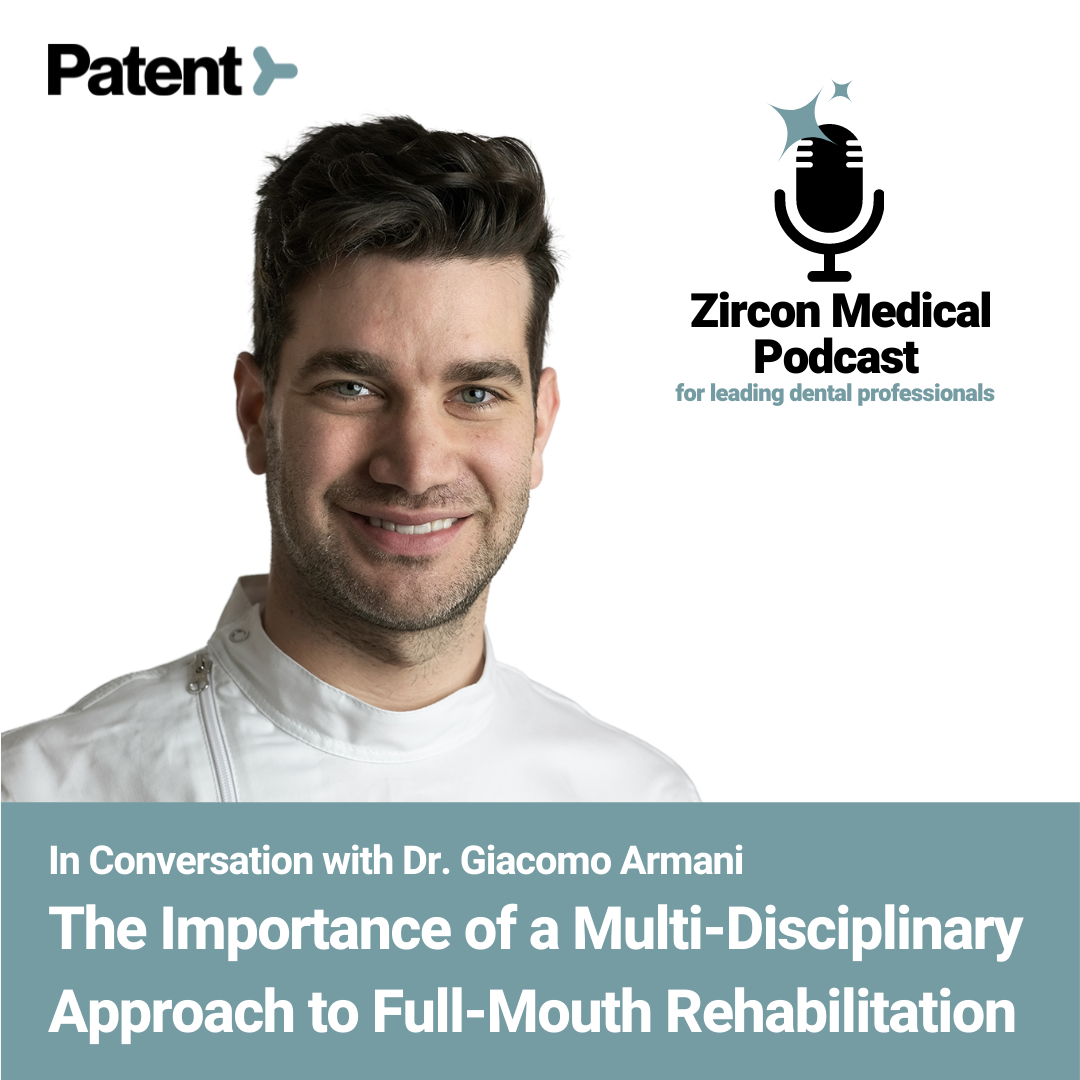Dr. Giacomo Armani
Prosthodontist at Studio Dentistico Armani
Studied dentistry in Romania
Owner of a dental clinic with his brother, Leonardo Armani, and sister, Camilla Armani
Facebook: https://www.facebook.com/Dr-Giacomo-Armani-276995039687959/
LinkedIn: https://www.linkedin.com/in/giacomo-armani-3384b954/
Instagram: https://www.instagram.com/dr.giacomoarmani/
Location: Via Angelo Butturini 13, Pescantina VR
Via Angelo Butturini, 13, 37026 Pescantina VR, Italy
In Conversation with Dr. Giacomo Armani
Full-mouth rehabilitation is a complex procedure that necessitates knowledge of multiple disciplines of dentistry, including orthodontics, oral surgery, and prosthodontics. Because of the complexities involved in the procedure, the value of curating a streamlined and dynamic workflow cannot be understated. Dr. Giacomo Armani’s dental clinic follows a multi-disciplinary approach to full-mouth rehabilitation to ensure optimal results and efficiency.
Our team at Zircon Medical hosted Dr. Armani on our podcast series to discuss the importance of a multi-disciplinary approach to full-mouth rehabilitation and his team’s comprehensive, holistic workflow.
Introducing Dr. Giacomo Armani, the prosthodontist at Studio Dentistico Armani, Verona
Dr. Giacomo Armani is the leading prosthodontist at Studio Dentistico Armani, a dental clinic he owns and runs with his brother, Dr. Leonardo Armani, and sister, Dr. Camilla Armani. The dental clinic was originally established and run by their father, who was also a doctor. However, it was originally a small-scale family practice, even though they received a lot of patients from downtown Verona. When Dr. Giacomo and his siblings took over, they decided to update the dental clinic and make it more modern.
The Armani siblings followed in their father’s footsteps, but they wanted to do something bigger with the dental clinic. They divided their professional fields according to different specialties. Dr. Camilla liked working with children, so she became the pediatric dentist. Dr. Leonardo was interested in surgeries, so he became an oral surgeon. And Dr. Giacomo became the prosthodontist and completed his Ph.D. in implant studies. Together, the siblings coordinate with all the other doctors in the clinic to curate comprehensive, minimally-invasive full-mouth rehabilitation plans for the patient.
The Armani workflow for full-mouth rehabilitation
Dr. Giacomo says he and his siblings have, over the years, curated a comprehensive, dynamic, and modern workflow for full-mouth rehabilitation. The workflow was developed gradually as they tweaked their processes over several years of heated conversations and debates around their round table. His brother would come up with academic ideas for how patients should be treated, someone else would pitch ideas for the aesthetics and prosthetics, and so they fine-tuned the process until it was perfect.
In its current iteration, there are seven essential steps in the full-mouth rehabilitation workflow.
Step 1: Diagnosis
The full-mouth rehabilitation workflow starts with the first visit, wherein they understand the patient’s chief complaints. They gather the patient’s data, including the first dental impression and radiographic status, to gauge which tooth has the correct prognosis. The team analyzes the findings during their weekly medical meetings, helps every Thursday from 9 to 12.
At this stage, they discuss the treatment plan and diagnosis with the orthodontist, periodontist, dental hygienist, and the treatment coordinator. While Dr. Armani presents the medical plan to the patient, the treatment coordinator presents the financial plan and highlights every step involved in the treatment process, including the number of visits, the dentists involved, and more.
Step 2: Testing
After receiving the patient’s approval, they construct a 3D model in the dental laboratory and try it on the patient. The prosthetic must be tested in the patient’s mouth to ensure it’s correct and suitable. The patient will wear it for a week, and if they’re comfortable, they’ll proceed with the next step in the full-rehabilitation workflow.
Step 3: Correction
After testing the prosthetics and 3D plan, they proceed with the correction phase. At this stage, the patient’s mouth is prepared for the final rehabilitation. This may involve restorative dentistry, endodontic dentistry, orthodontic dentistry, bone surgery, or periodontal surgery, depending on the patient’s oral health and conditions.
Step 4: Reevaluation
The entire team reevaluates the treatment plan after the necessary corrections are made. They ensure the patient doesn’t have infections, caries, misalignment, and other problems. Finally, they collect the data from the corrective treatments and proceed with the prosthetic phase, i.e., designing and providing the necessary prosthetics.
Step 5: Prosthetics
Dr. Armani takes impressions of the patient’s teeth to prepare the necessary prosthetics. This involves taking impressions for implants, veneers, or other types of dental work. The primary goal is to ensure the final prosthetic is designed and placed according to the patient’s liking and preference.
Step 6: Delivery
After preparing the prosthetics, they deliver the treatment to the patient. This involves performing the implant surgery or placing the crowns, veneers, and other prosthetics. Most patients consider this the final stage of the journey, but Dr. Armani’s team includes another essential step, which they believe is crucial for the prosthetic’s longevity.
Step 7: Maintenance
Dr. Armani and his team provide a guarantee that they’ll be responsible for the treatment cost if something goes wrong. However, they only provide this guarantee if the patient is completely willing to maintain the results by showing up for regular dental exams and cleanings. This allows the dentists to monitor the progress and ensure everything is going according to plan.
During the regular maintenance sessions, the dental hygienist examines the patient’s gum condition, cleans the plaque and tartar, and ensures they have perfect oral health. The patient shouldn’t have infections or fractures at any stage of the treatment. They guarantee that everything will be fine if the patient follows their instructions and shows up regularly..
A multi-disciplinary approach to full-mouth rehabilitation is essential
When asked if individual dentists can follow this comprehensive workflow for full-mouth rehabilitation, Dr. Giacomo hesitated before saying, “multi-disciplinary treatments and standalone concepts are opposite poles.” He further illustrates that a multi-disciplinary isn’t merely a preference but an essential component of full-mouth rehabilitation.
To highlight the importance of a multi-disciplinary approach, Dr. Giacomo describes the value of collaboration between different specialties. He says the prosthodontist is the key to the dental team because he’s the last actor in the complete sequence of events involved in full-mouth reconstruction, i.e., the prosthodontist is responsible for restoring the patient’s prosthetics.
“The prosthodontist has to decide where to place the teeth at the end of the treatment,” Dr. Giacomo says. “The patient doesn’t care where you place the titanium implant in the bone; all they care about is how you chew and look. As such, the prosthodontist must have a holistic view of the full-mouth rehabilitation, and they should be capable of guiding the entire team.
“If the surgeon creates the treatment plan,” Dr. Giacomo says, “he’ll place the implant according to the bone, without caring about how the crown will look.” The surgeon can advise the prosthodontist on the ideal location for the implant and whether bone grafting is necessary, but the primary goal for the patient is a visible and functional crown.
Meanwhile, Dr. Giacomo says orthodontists would likely focus on ensuring the upper teeth are perfectly aligned with the lower teeth. While that’s the ideal location, it’s not an essential component of full-mouth rehabilitation. The primary goal is attaching the prosthetic in a reliable position and completing it with optimal aesthetic and functional value.
Dr. Giacomo also highlights that an inter-disciplinary treatment is challenging to implement because all dentists have extremely strong opinions, which can lead to conflicts. However, it’s crucial to listen to other specialties. For example, if the surgeon says one of the teeth has a prognosis of only 5 years, the prosthodontist has no option but to look for a suitable alternative plan.
Convincing the patient about the dental treatment
Dr. Giacomo says they also have a responsibility to understand the patient and their goals during the initial consultation. He says all dentists must listen to their patient's primary concerns. Otherwise, the dental team might find itself working for zero because the patients will simply refuse the treatment, even after hours of time and effort. That’s why they must all prudently assess the patient and listen to their true concerns, just as they must listen to each other.
When asked about his goals for the future, Dr. Armani said he intends to build another part of the clinic, which will allow them to accept even more patients. He’s also working on a YouTube channel called ArmaniTV, where he wants to upload extremely detailed videos about how to place implants, how to do bonding and other dentistry-related subjects.












